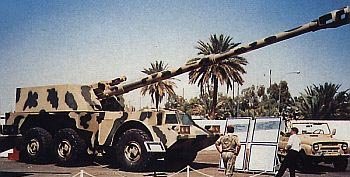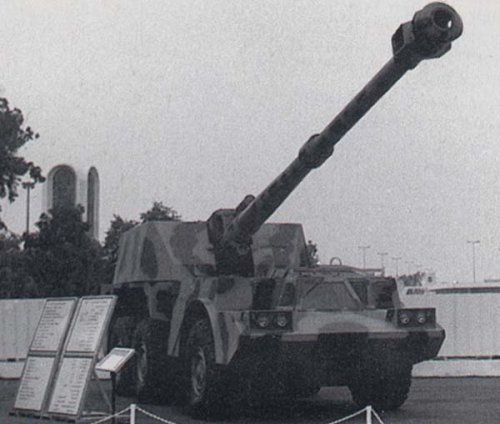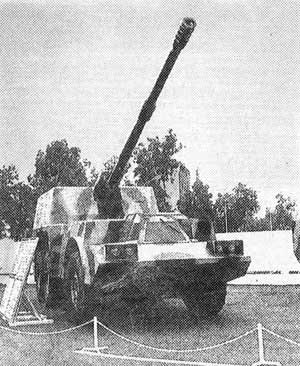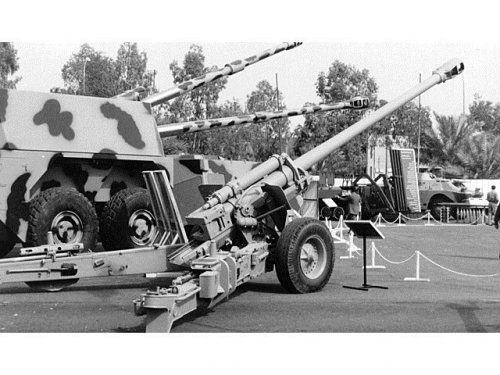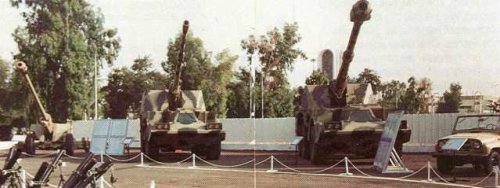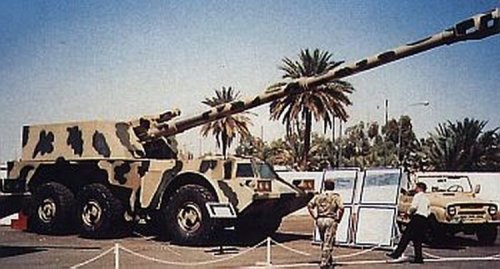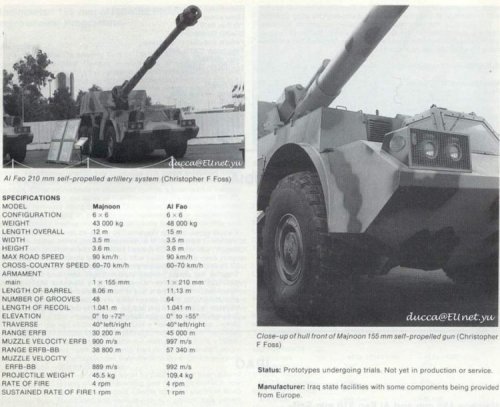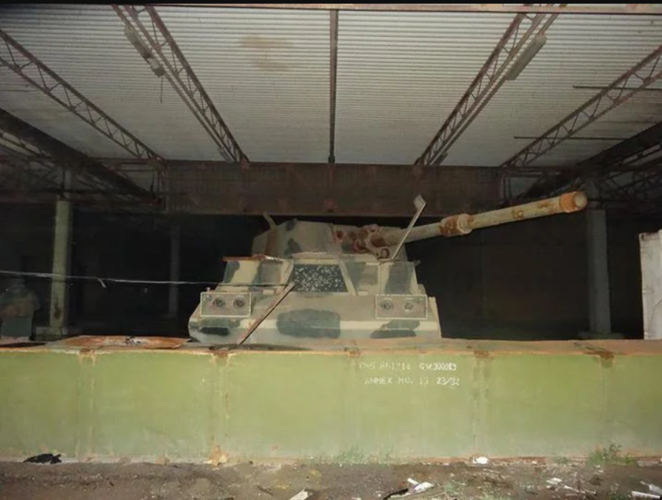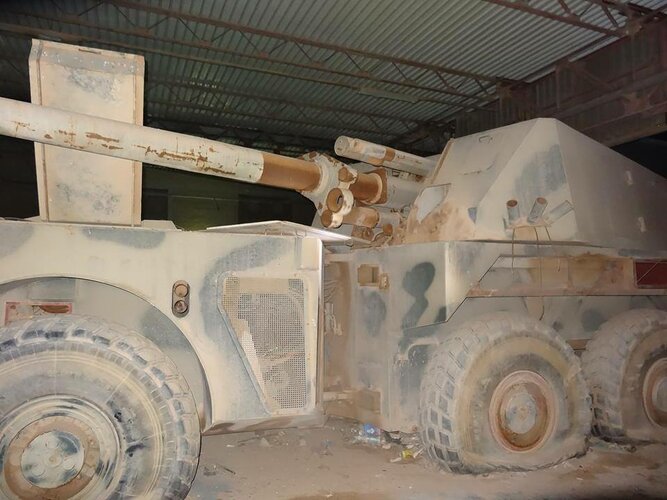You are using an out of date browser. It may not display this or other websites correctly.
You should upgrade or use an alternative browser.
You should upgrade or use an alternative browser.
Iraqi heavy artillery pre Desert Storm
- Thread starter razor
- Start date
V8Interceptor
ACCESS: Restricted
- Joined
- 3 March 2009
- Messages
- 30
- Reaction score
- 3
I know that a single prototype of the 210MM Al Fao SPG constructed but I wasn't aware of a 240MM system..Some of the older editons of Jane's AFV's have Al Fao pics, but unfortunatly I do not own any of them..razor said:Does anyone have any data/pix/drawings of the 21cm, 24cm guns developed in conjunction with Dr Bull or any of his other developments that reached the hardware stage ???
- Joined
- 25 July 2007
- Messages
- 4,088
- Reaction score
- 3,643
A couple of well-know photos but they give the flavour. Some of the specs are a little suspect, vehicle weight is downright goofy (I've added G6 details for comparison).
Al Fao data:
Caliber: 210 mm
Barrel length: L/70 approx [G6 45 or 52 calibers]
Length (OA): about 15,000 mm [G6 LOA 10,335 mm]
Length (hull) : about 11,000 mm [G6 hull 9200 mm]
Weight: 48000 kg
Max. range: 45,000 m (EFRB projectile, 109 kg), 57,340 m (ERFB-BB)
RoF: 4 rpm
Elevation: +-40° [G6 -5° to +75°]
Traverse: 55° [G6 traverse 80°]
SPG [OMC G6 Rhino-type vehicle]
Crew: 6 [G6 only 5]
Weight: 28,200 Kg [? G6 is 37t [pre-production], 45t [prod.], G6-52 is 49t]
Speed: 80 km/h [G6 90 km/h]
Range: 400 km [G6 700 km]
Al Fao data:
Caliber: 210 mm
Barrel length: L/70 approx [G6 45 or 52 calibers]
Length (OA): about 15,000 mm [G6 LOA 10,335 mm]
Length (hull) : about 11,000 mm [G6 hull 9200 mm]
Weight: 48000 kg
Max. range: 45,000 m (EFRB projectile, 109 kg), 57,340 m (ERFB-BB)
RoF: 4 rpm
Elevation: +-40° [G6 -5° to +75°]
Traverse: 55° [G6 traverse 80°]
SPG [OMC G6 Rhino-type vehicle]
Crew: 6 [G6 only 5]
Weight: 28,200 Kg [? G6 is 37t [pre-production], 45t [prod.], G6-52 is 49t]
Speed: 80 km/h [G6 90 km/h]
Range: 400 km [G6 700 km]
Attachments
Apophenia said
48,000 fits fairly well with G6-52, while 28,200 could be simply a typo for 48,200? Such things do get past proof-readers sometimes.
There are two weights quoted, 48000kg and 28,200kg.vehicle weight is downright goofy
48,000 fits fairly well with G6-52, while 28,200 could be simply a typo for 48,200? Such things do get past proof-readers sometimes.
- Joined
- 18 March 2008
- Messages
- 3,529
- Reaction score
- 845
smurf said:Apophenia saidThere are two weights quoted, 48000kg and 28,200kg.vehicle weight is downright goofy
48,000 fits fairly well with G6-52, while 28,200 could be simply a typo for 48,200? Such things do get past proof-readers sometimes.
If their 210mm L70 SPG weighs in at 48 tonnes then their 155mm L45 SPG is going to be a lot lighter. At least 10 tonnes lighter for the difference between the ordnance and their cradles. The G6-52 ups the weight because of all the extra systems (turret APU, automatic loading assembly, etc) which are not features on the Al Fao and G-6. Also the G-6 adds a lot of weight thanks to its heavy frontal armour (resistant against 23mm) that may be dispensed with in the Al Fao (saving at least 5 tonnes). 28 tonnes is not an unrealistic weight for a wheeled 155mm L45 self-propelled gun system.
- Joined
- 25 July 2007
- Messages
- 4,088
- Reaction score
- 3,643
Abraham was referring to the Iraqi 155mm Majnoon SPG. This used another Bull/Space Research Corporation gun, the 155mm L/45 howitzer known as Al Majnum in Iraqi service (SRC GC-45, Noricum GHN-45, or Denel G5 elsewhere). The G5 is, of course, the gun in the G6 Rhino.
From Armada International, Aug/Sept 1989:
"... the Iraqis showed two new gun systems on articulated wheeled 6X6 chassis. One was a 155 mm unit known as the Majnoon which fires a ERFB BB round to 38 000 metres. On a similar chassis was the Al Fao with a 210 mm barrel.
The Al Fao and Majnoon share the same turret and chassis but the A1 Fao with its unusual 210 mm gun is something of a revelation. According to data supplied by Baghdad the 210 mm gun fires a 109.4 kg ERFB BB projectile to a maximum range of no less than 57 340 metres. This is way in excess of any other artillery piece in service or on the drawing board."
From Armada International, Aug/Sept 1989:
"... the Iraqis showed two new gun systems on articulated wheeled 6X6 chassis. One was a 155 mm unit known as the Majnoon which fires a ERFB BB round to 38 000 metres. On a similar chassis was the Al Fao with a 210 mm barrel.
The Al Fao and Majnoon share the same turret and chassis but the A1 Fao with its unusual 210 mm gun is something of a revelation. According to data supplied by Baghdad the 210 mm gun fires a 109.4 kg ERFB BB projectile to a maximum range of no less than 57 340 metres. This is way in excess of any other artillery piece in service or on the drawing board."
Thanks. That clarifies things a bit. My real interests are naval, and pre-1960 at that, but a prewar British 6in L50 gun weighed about 7 tons, while an L50 8in weighed 17tons. So add more than 10tons for the gun, plus a bit more for longer barrel, stronger supports etc and heavier ammunition (though fewer rounds carried) could take the total from 28t comparable to the Rhino (not an unreasonable weight for a 155mm as AG said) to well over 40t. Shell weight of 109kg is typical 8in, compared to around 45-50kg for a 6in. (+ wt of propellant charge in proportion). All quite rough estimates.
As I see it, the main problem is will essentially the same chassis stand the extra weight, and how has it been 'beefed up'? But a Centurion chassis for SPGs stood guns from 25pdr through 5.5in howitzer to a 180mm high velocity A/T weapon, though the 25pdr was already around 40t IIRC. That apart, I don't really see a problem with the values quoted for the weights.
As I see it, the main problem is will essentially the same chassis stand the extra weight, and how has it been 'beefed up'? But a Centurion chassis for SPGs stood guns from 25pdr through 5.5in howitzer to a 180mm high velocity A/T weapon, though the 25pdr was already around 40t IIRC. That apart, I don't really see a problem with the values quoted for the weights.
Well there's that book written by Gerald Bull before before he took the bullet called, 'Paris Kanonen--The Paris Guns Wilhelmgeschütze and Project HARP'. Brief mention of Bull's work in Iraq but more on Project Harp and the Paris Canon. Rare like hen's teeth thought and sells for silly amounts of money if you can find one. I managed to track down a copy at a decent price from a bookseller in Zurich about 5 years but had to sell to pay the bills.
- Joined
- 27 March 2006
- Messages
- 1,815
- Reaction score
- 1,428
Just a quick sidenote.
The 37 tons as given for the South African G-6 all appear in early publications. All other first hand literature has since listed it's weight as 45 or 47 tons. The G-6 is a large vehicle, so this latter weight makes sense.
I have always regarded the 37 ton listing as probably for the 3 pre-production G-6's that performed such sterling work in Southern Angola in the late 1980's.
The 37 tons as given for the South African G-6 all appear in early publications. All other first hand literature has since listed it's weight as 45 or 47 tons. The G-6 is a large vehicle, so this latter weight makes sense.
I have always regarded the 37 ton listing as probably for the 3 pre-production G-6's that performed such sterling work in Southern Angola in the late 1980's.
- Joined
- 27 March 2006
- Messages
- 1,815
- Reaction score
- 1,428
That's basically how I understand it Apophenia. This from a variety of sources.
It appears many internet sites and publications took the early data as published by Helmoed-Romer Heitman. This data (inclusive of the 37 ton weight) was for the 3 pre-production models as used operationally by the SADF in Angola to test and validate the design.
It appears many internet sites and publications took the early data as published by Helmoed-Romer Heitman. This data (inclusive of the 37 ton weight) was for the 3 pre-production models as used operationally by the SADF in Angola to test and validate the design.
Eagle2009
ACCESS: Confidential
- Joined
- 8 February 2010
- Messages
- 166
- Reaction score
- 211
- Joined
- 9 October 2009
- Messages
- 20,810
- Reaction score
- 11,781
Project Babylon - Wikipedia
- Joined
- 11 March 2012
- Messages
- 3,080
- Reaction score
- 2,861
I toured Dr. Gerald Bulls test-range at High Water, Quebec back in 1967. He bragged that he could shell Moscow with enough gun-powder/ Most of those guns were USN-surplus battleship barrels welded end-to-end to double their length.Well there's that book written by Gerald Bull before before he took the bullet called, 'Paris Kanonen--The Paris Guns Wilhelmgeschütze and Project HARP'. Brief mention of Bull's work in Iraq but more on Project Harp and the Paris Canon. Rare like hen's teeth thought and sells for silly amounts of money if you can find one. I managed to track down a copy at a decent price from a bookseller in Zurich about 5 years but had to sell to pay the bills.
Bull as built a test-range in the Barbados.
He contracted with CARDE and the US Army to improve artillery range, then went on the help India and South Africa improve their heavy artillery. There was a scandal when a journalist discovered some British-made tubes destined for South Africa. I have long suspected that the Ottawa and Washington knew exactly how Bull was helping the apartheit regime in South Africa, but turned a blind eye. South African artillery thrashed communists in Angola.
Desperate for anyone to finance his ballistic research Dr. Bull contracted to build super-guns for Saddam Hussein's Iraq. Since they feared that Iraqi super-guns might shell Jerusalem, the Israelis tried to warn him off. When Dr. Bull ignored Israeli warnings, he was assassinated in Belgium. Since the professional killers left no evidence, most believe that Dr. Bull was killed by the Israeli Mossad.
Pity!
Last edited:
- Joined
- 25 July 2007
- Messages
- 4,088
- Reaction score
- 3,643
... built a test-range in the Bahamas (?)...
Close. It was the Government of Barbados which allowed SRC/Bull to establish a base at Foul Bay on the SE coast of the island. This HARP test range was permitted in exchange for providing an improved radar system at BGI.
He bragged that he could shell Moscow with enough gun-powder
He was aiming for orbit with Martlet IV. And once in the right orbit, you can bomb plenty of places on Earth.
- Joined
- 3 September 2006
- Messages
- 1,422
- Reaction score
- 1,315
They like the way you're thinkingSince the professional killers left no evidence, most believe that Dr. Bull was killed by the Israeli Mossad.
It's like the circumstantial evidence for the raid that eliminated the head of PLO terrorist arm in Tunis: they came in, nobody saw them, there was his son and his wife, they killed only him, didn't hurt the son nor the wife: Then it can only be the Israelis!
Sadly, it says more about themselves than about Mossad...
Mark Wade has it that it wasn’t the super gun that put Bull on the Mossad’s radar:
Only China looks at superguns now:

 futurism.com
futurism.com
Only China looks at superguns now:

China Uses Giant Rail Gun to Shoot Smart Bomb Nine Miles Into the Sky
China's navy has apparently tested out its hypersonic rail gun — but during a demonstration of its power, things didn't go quite as planned.
Last edited:
Scott Kenny
ACCESS: Above Top Secret
- Joined
- 15 May 2023
- Messages
- 8,136
- Reaction score
- 8,457
Huh...Mark Wade has it that it wasn’t the super gun that put Bull on the Mossad’s radar:
That's a phrase usually used to describe gunpowder...At the time, Iraq had many Scud missiles to provide a technology source. The Scud was a short-range ballistic missile exported by the Soviet Union in large numbers. Iraq had conducted modifications on the missiles to increase their range. Space Research Corporation evaluated several different options, including configurations of four to six extended-burn-time Scud rockets clustered around a single extended-burn-time Scud as a second stage and a new third stage. By early 1989, the Space Research Corporation had settled on a design consisting of five Scuds clustered for the first stage, another for the second stage, and a “double-base propellant” rocket for the third stage.
Using a railgun to launch people is a bad idea. Same problem as a gunpowder cannon, too much acceleration. Remember, rockets max out at about 3.5 gees for passenger flights, which means you need an accelerator at least 1000x longer than one used for artillery to the same height/range. If not 3000x longer.Only China looks at superguns now:

China Uses Giant Rail Gun to Shoot Smart Bomb Nine Miles Into the Sky
China's navy has apparently tested out its hypersonic rail gun — but during a demonstration of its power, things didn't go quite as planned.futurism.com
Scott Kenny
ACCESS: Above Top Secret
- Joined
- 15 May 2023
- Messages
- 8,136
- Reaction score
- 8,457
Makes it trivially easy to prove it's a military-only weapon when the people mover needs to be (example) 20-60km long with associated construction budget, though.True--but the "launch-people" part was likely a cover.
Ravinoff
Hoodoo Operator
- Joined
- 5 October 2017
- Messages
- 112
- Reaction score
- 255
Loosely relevant to the topic at hand, and just kinda interesting: Iraq also had an unknown (but likely very small) number of North Korean M-1978 Koksan 170mm SPGs, with at least one converted to carry a 180mm S-23 heavy howitzer. I'm not clear on how much - if any - actual use they saw, but the story of how they came to be there is fairly neat and something you don't often see after WWII. North Korea was and is on relatively good terms with Iran, and during the Iran-Iraq War that relationship manifested with North Korea providing a number of M-1978s to aid Iran. They were apparently put to work and not just show pieces, because by the end of the war in 1989, the Iraqi military captured several and brought them back as trophies. Records are sparse to nonexistent, but it seems that at least some were put on public display.
Here's where it gets a bit tricky to keep track of: at least one of the captured M-1978s was towed to the University of Anbar (Ramallah) in 2003, where 2/5 Field Artillery Battalion wanted to bring it back to the US as a trophy. The logistics for that never materialized, and eventually it was disabled with thermite and left on the university campus. Then, in 2008, reports come up again mentioning an M-1978 at Anbar University, this time being recovered and towed away by the USMC. Logic would dictate it's probably the same one, but I can't find anything confirming that. In any case, that was one of the 180mm S-23 conversions with the distinctive muzzle brake of that series.


And it seems like Iran still has a few around as of 2014, at least, this one was seen on parade in Tehran that year. I think I can make out "170mm" written on the side of it, and the muzzle brake is different, suggesting that the 180mm conversion was an Iraqi project.

Here's where it gets a bit tricky to keep track of: at least one of the captured M-1978s was towed to the University of Anbar (Ramallah) in 2003, where 2/5 Field Artillery Battalion wanted to bring it back to the US as a trophy. The logistics for that never materialized, and eventually it was disabled with thermite and left on the university campus. Then, in 2008, reports come up again mentioning an M-1978 at Anbar University, this time being recovered and towed away by the USMC. Logic would dictate it's probably the same one, but I can't find anything confirming that. In any case, that was one of the 180mm S-23 conversions with the distinctive muzzle brake of that series.
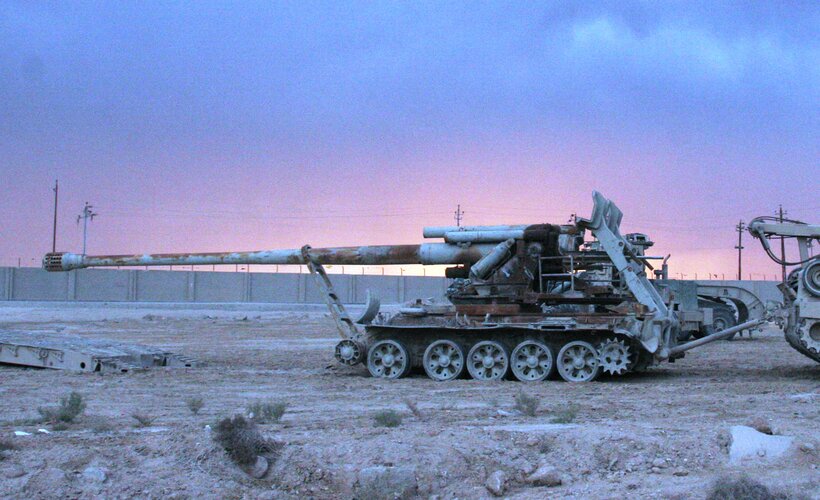
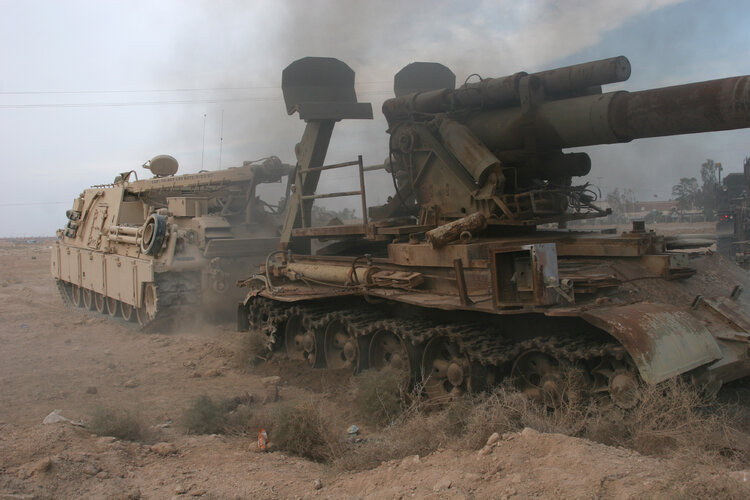
And it seems like Iran still has a few around as of 2014, at least, this one was seen on parade in Tehran that year. I think I can make out "170mm" written on the side of it, and the muzzle brake is different, suggesting that the 180mm conversion was an Iraqi project.
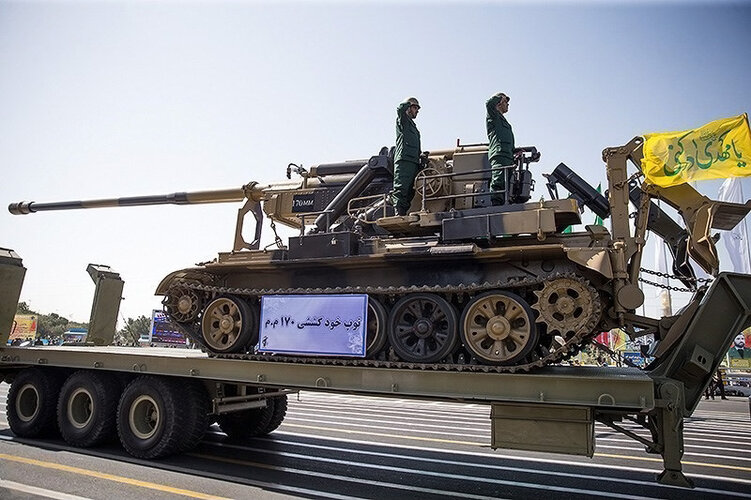
Similar threads
-
Alternate aircraft in Iran Iraq war
- Started by Monk78
- Replies: 21
-
-
South African artillery/cannon/guns - prototypes, projects, concepts etc.
- Started by Graugrun
- Replies: 132
-
South African small to medium calibre weapon prototypes, concepts, projects etc.
- Started by Graugrun
- Replies: 137
-
Impact on the Iran-Iraq War if Iran had bought A-10s
- Started by CJGibson
- Replies: 4

